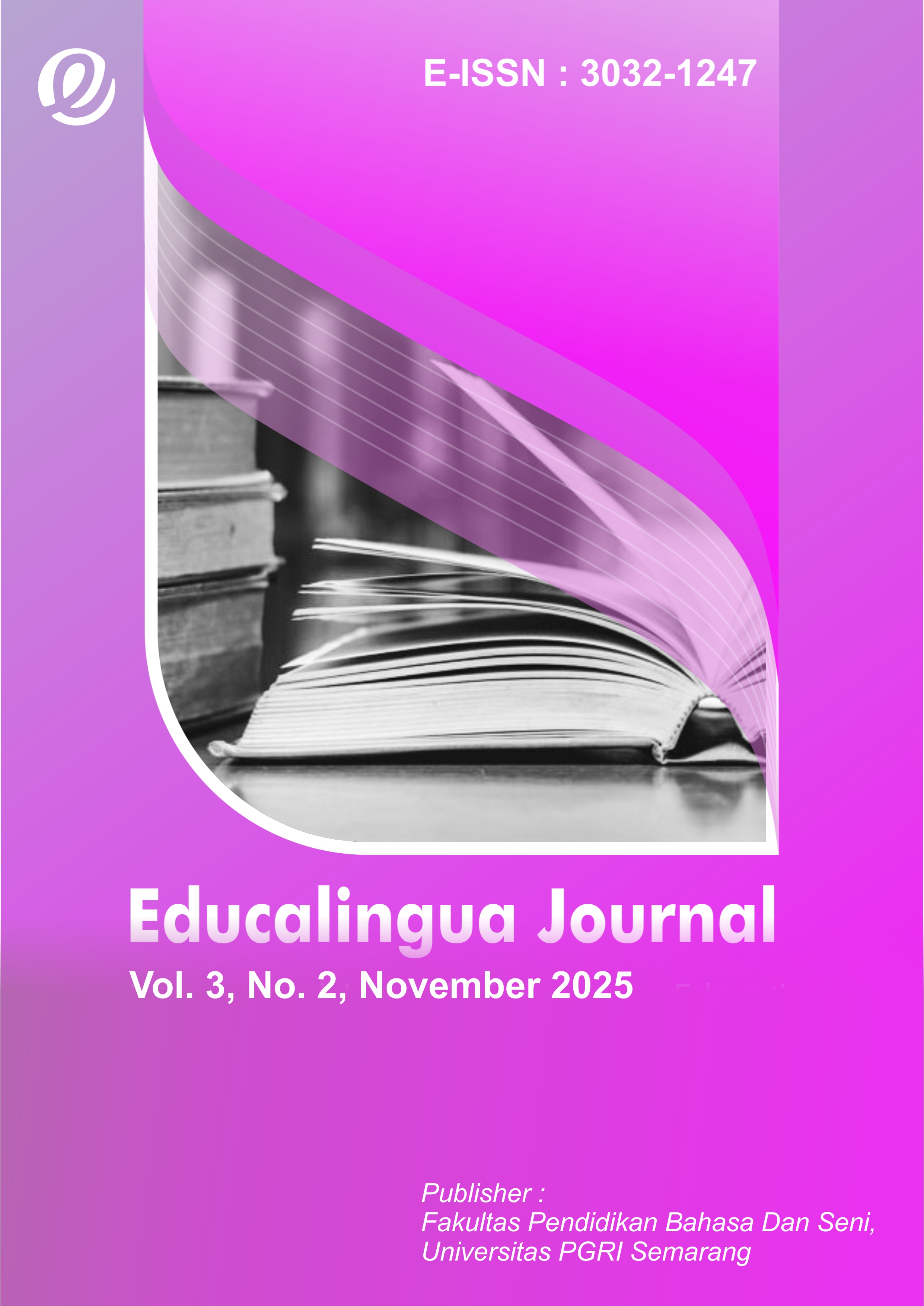Linguistic Crossroads: How do Indonesian Mother Tongues Shape English Language Acquisition?
DOI:
https://doi.org/10.26877/educalingua.v3i2.2301Keywords:
EFL learners, Indonesian language, language interference,, phonological errors, second language acquisitionAbstract
The influence of the mother tongue on second language acquisition has been widely studied, yet its specific impact on Indonesian learners of English remains underexplored. Grounded in the theoretical framework of language transfer and contrastive analysis, this study examines how the Indonesian language affects English pronunciation, grammar, and vocabulary acquisition. The research employed a qualitative approach, analyzing the linguistic patterns of Indonesian EFL learners through phonological, syntactic, and lexical perspectives. Findings indicate that phonological interference leads to sound substitution and syllable epenthesis, while syntactic transfer results in grammatical errors such as auxiliary omission and incorrect word order. Additionally, lexical interference causes misinterpretations due to false cognates and direct translations. These findings highlight the persistent influence of the mother tongue in shaping English proficiency. The study suggests that increasing exposure to authentic English input and employing explicit linguistic instruction can mitigate these challenges. Future research should explore intervention strategies and assess the long-term impact of language transfer. The study contributes to a deeper understanding of second language acquisition in multilingual contexts and offers pedagogical insights for EFL teachers in Indonesia.
References
Abu Sahyon, A. S. A. E., Alzyoud, A., Alshorman, O., & Al-Absi, B. (2023). AI-driven technology and Chatbots as tools for enhancing English language learning in the context of second language acquisition: a review study. International Journal of Membrane Science and Technology, 10(1), 1209-1223. https://doi.org/10.15379/ijmst.v10i1.2829
Ahmed, A., & Morgan, B. (2021). Postmemory and multilingual identities in English language teaching: A duoethnography. The Language Learning Journal, 49(4), 483-498. https://doi.org/10.1080/09571736.2021.1906301
Alharbi, S. H. (2021). The Struggling English Language Learners: Case Studies of English Language Learning Difficulties in EFL Context. English Language Teaching, 14(11), 108-117. https://doi.org/10.5539/elt.v14n11p108
Anggaira, A. S., Elfanastarini, I., Ferdianyah, B., & Devania, S. P. (2024). Cultural Crossroads: English Instruction in Indonesian Islamic Schools.
Aribah, S. N., & Pradita, I. (2022). The use of translanguaging to facilitate students’ English learning in an Indonesian Pesantren. Communications in Humanities and Social Sciences, 2(1), 7-13. https://doi.org/10.21924/chss.2.1.2022.27
Bacha, M. S., Kumar, T., Bibi, B. S., & Yunus, M. M. (2021). Using English as a lingua franca in Pakistan: Influences and implications in English Language Teaching (ELT). Asian ESP Journal, 17(2), 155-175.
Benu, N. N., Artawa, I. K., Satyawati, M. S., & Purnawati, K. W. (2023). Local language vitality in Kupang city, Indonesia: A linguistic landscape approach. Cogent Arts & Humanities, 10(1), 2153973. https://doi.org/10.1080/23311983.2022.2153973
Bjornsson, A. (2023). The Influence of Social Media on English Language Acquisition: A Quantitative Study. Research Studies in English Language Teaching and Learning, 1(3), 127-138. https://doi.org/10.62583/rseltl.v1i3.15
Braun, V., & Clarke, V. (2006). Using thematic analysis in psychology. Qualitative research in psychology, 3(2), 77-101. https://doi.org/10.1191/1478088706qp063oa
Bylund, E., Khafif, Z., & Berghoff, R. (2024). Linguistic and geographic diversity in research on second language acquisition and multilingualism: An analysis of selected journals. Applied Linguistics, 45(2), 308-329. https://doi.org/10.1093/applin/amad022
Creswell, J. W., & Clark, V. L. P. (2017). Designing and conducting mixed methods research. Sage publications.
Demirdag, M. C., Kucuk, S., & Tasgin, A. (2025). An investigation of the effectiveness of augmented reality technology supported English language learning activities on preschool children. International Journal of Human–Computer Interaction, 41(4), 2410-2423. https://doi.org/10.1080/10447318.2024.2323278
Dewaele, J. M., Saito, K., & Halimi, F. (2022). How teacher behaviour shapes foreign language learners’ enjoyment, anxiety and attitudes/motivation: A mixed modelling longitudinal investigation. Language Teaching Research, 13621688221089601. https://doi.org/10.1177/13621688221089601
Dzhubanova, S. (2024). Assessing the Impact of Cross-Cultural Interactions on English Language Acquisition in Kazakhstan's Educational System. Eurasian Science Review an International peer-reviewed multidisciplinary journal, 2(2), 118-123. https://doi.org/10.63034/esr-51
Holton, E. F., & Burnett, M. F. (2005). The basics of quantitative research. Research in organizations: Foundations and methods of inquiry, 29-44.
Jindapitak, N., Teo, A., & Savski, K. (2022). Bringing Global Englishes to the ELT classroom: English language learners’ reflections. Asian Englishes, 24(3), 279-293.
Johnson, R. B., & Onwuegbuzie, A. J. (2004). Mixed methods research: A research paradigm whose time has come. Educational researcher, 33(7), 14-26. https://doi.org/10.3102/0013189X033007014
Kumar, T., Kumar Roy, V., & Yunus, M. M. (2023). Adopting learning strategies for English language acquisition on secondary level students.
Liando, N. V. F., & Tatipang, D. P. (2022). English or Indonesian language? Parents’ perception toward children's second language learning context. Jurnal Lingua Idea, 13(1), 61-75. https://doi.org/10.20884/1.jli.2022.13.1.5749
Mahapatra, S. K., & Anderson, J. (2023). Languages for learning: a framework for implementing India’s multilingual language-in-education policy. Current Issues in Language Planning, 24(1), 102-122. https://doi.org/10.1080/14664208.2022.2037292
Meir, N., & Janssen, B. (2021). Child heritage language development: An interplay between cross-linguistic influence and language-external factors. Frontiers in Psychology, 12, 651730. https://doi.org/10.3389/fpsyg.2021.651730
Mirvahedi, S. H. (2022). Linguistic Landscapes in South-East Asia. Routledge. https://doi.org/10.4324/9781003166993
Mislawiyadi, M. (2024). Unveiling the Dynamics: A Comprehensive Exploration of Formal Learning in Second Language Acquisition Theory: English. JOEY: Journal of English Ibrahimy, 3(1), 59-70. https://doi.org/10.35316/joey.2024.v3i2.65-74
Nugraha, I. S., & Sukarno, S. (2025). Environmental Support in Promoting Students’ English Language as Second Language Acquisition: A Case in at-
Tawazun Modern Islamic Boarding School. Formosa Journal of Sustainable Research, 4(2), 219-236. https://doi.org/10.55927/fjsr.v4i2.26
Poudel, P. P., & Choi, T. H. (2022). Discourses shaping the language-in-education policy and foreign language education in Nepal: An intersectional perspective. Current Issues in Language Planning, 23(5), 488-506. https://doi.org/10.1080/14664208.2021.2013063
Reynolds, B. L., Liu, S., Milosavljevic, M., Ding, C., & McDonald, J. (2021). Exploring pre-service pre-primary EFL teacher beliefs about teaching English to very young learners: A Macau case study. Sage Open, 11(4), 21582440211052932. https://doi.org/10.1177/21582440211052932
Robert, R., & Meenakshi, S. (2022). Rereading oral communication skills in English language acquisition: The unspoken spoken English. Theory and Practice in Language Studies, 12(11), 2429-2435. https://doi.org/10.17507/tpls.1211.25
Rose, H., Sahan, K., & Zhou, S. (2022). Global English medium instruction: Perspectives at the crossroads of global Englishes and EMI. Asian Englishes, 24(2), 160-172. https://doi.org/10.1080/13488678.2022.2056794
Rostandi, U. D., & Rohandy, F. (2024). Language acquisition and identity negotiation: Discursive positioning of Indonesian adolescents learning English. Indonesian Journal of Applied Linguistics, 13(3), 562-572. https://doi.org/10.17509/ijal.v13i3.66919
Sah, P. K., & Li, G. (2022). Translanguaging or unequal languaging? Unfolding the plurilingual discourse of English medium instruction policy in Nepal’s public schools. International Journal of Bilingual Education and Bilingualism, 25(6), 2075-2094. https://doi.org/10.1080/13670050.2020.1849011
Singh, L., Cheng, Q., Tan, S. H., Tan, A., & Low, Y. L. (2022). Language acquisition in a multilingual society: English vocabulary norms and predictors in Singaporean children. Child Development, 93(1), 288-305. https://doi.org/10.1111/cdev.13676
Sholah, H. M. (2021). The effect of mother language toward the mastery of English language acquisition; case of Indonesian students in English learning process. Tafhim Al-'Ilmi, 13(1), 117-141. https://doi.org/10.37459/tafhim.v13i1.4646
Sudarmanto, B. A., Wahyuni, T., Aji, E. N., Murdowo, D. A., Hendrastuti, R., Artawa, K., & Benu, N. N. (2023). The languages on the border of Indonesia and Timor Leste: A linguistic landscape study. Cogent Arts & Humanities, 10(2), 2273145. https://doi.org/10.1080/23311983.2023.2273145
Tambusai, A., & Nasution, K. (2024). A comparative typology of verbal affixes in Riau-Malay and Sundanese. Indonesian Journal of Applied Linguistics, 13(3), 636-647.
Tamtomo, K. (2016). The push and pull of language ideologies: Multilingual communicative practices among youths in an Indonesian city. State University of New York at Albany.
Wafiroh, L. L., & Indah, R. N. (2022). English language acquisition at Islamic boarding school: A systematic review. Journal of English Language and Pedagogy, 5(2), 111-120.
Yiling, J., Omar, M., & Kamaruzaman, F. M. (2025). Exploring the AI-Enhanced Project-Based Learning for English Language Acquisition: A Systematic Review of the Key Elements and Emerging Technology Trends. International Journal of Learning, Teaching and Educational Research, 24(2), 636-652. https://doi.org/10.26803/ijlter.24.2.31





